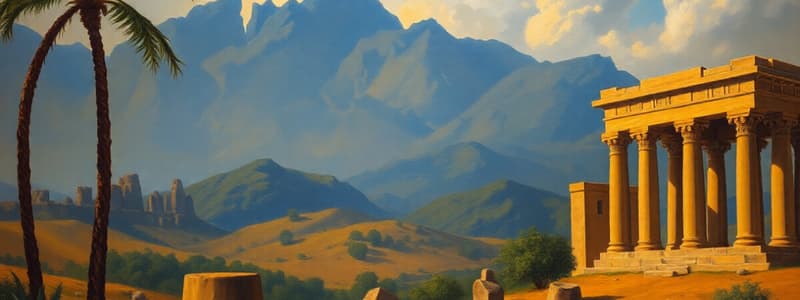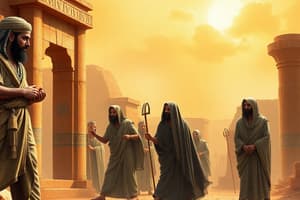Podcast
Questions and Answers
Compare and contrast the political systems of Athens and Sparta, highlighting the key differences between direct democracy and oligarchy. Consider the roles of prominent figures like Solon, Cleisthenes, and Lycurgus in shaping their respective societies.
Compare and contrast the political systems of Athens and Sparta, highlighting the key differences between direct democracy and oligarchy. Consider the roles of prominent figures like Solon, Cleisthenes, and Lycurgus in shaping their respective societies.
Athens, under the leadership of figures like Solon and Cleisthenes, developed a direct democracy where all citizens had the right to participate in government. This system emphasized individual participation and the power of the assembly. In contrast, Sparta, under the influence of Lycurgus, established an oligarchy ruled by a small group of elites known as the Gerousia. Spartan society was structured around strict military discipline and communal living, prioritizing collective goals over individual freedom.
Discuss the role of religion in both Athenian and Roman cultures, highlighting the similarities and differences in their religious beliefs and practices. Provide specific examples to support your analysis.
Discuss the role of religion in both Athenian and Roman cultures, highlighting the similarities and differences in their religious beliefs and practices. Provide specific examples to support your analysis.
Both Athenian and Roman cultures placed significant importance on religion. Athenians worshipped a pantheon of gods, including Zeus, Hera, and Poseidon, and incorporated religious rituals into their daily lives. Romans also adopted a polytheistic system, with gods like Jupiter, Juno, and Neptune. Both societies, with their emphasis on state-sanctioned official religions, viewed religion as an integral part of community and societal functioning. However, Rome, unlike Athens, experienced a gradual shift towards Christianity, with Constantine's official recognition of the religion in the 4th century CE.
Explain the factors contributing to the rise of the Roman Empire, examining the military, political, and economic factors that enabled Rome's expansion and dominance. How did the reign of Augustus Caesar mark a turning point in Roman history?
Explain the factors contributing to the rise of the Roman Empire, examining the military, political, and economic factors that enabled Rome's expansion and dominance. How did the reign of Augustus Caesar mark a turning point in Roman history?
The rise of the Roman Empire was a multifaceted process driven by a combination of factors. A strong military, with its strategic brilliance and efficient organization, enabled Rome to conquer and annex vast territories. Politically, the Roman Republic transitioned into an empire under the rule of Augustus Caesar, establishing a centralized authority and a system of provincial administration. Economically, Rome's control over key trade routes and its sophisticated infrastructure fueled economic growth and prosperity. Augustus' reign marked a significant turning point, establishing a period of relative peace and stability known as the Pax Romana, which laid the foundation for the empire's long-lasting influence.
Analyze the causes of the decline and eventual fall of the Roman Empire. Consider political, economic, social, and military factors that contributed to this historical event. How did factors like political instability, economic decline, and external pressures contribute to the fall of the empire?
Analyze the causes of the decline and eventual fall of the Roman Empire. Consider political, economic, social, and military factors that contributed to this historical event. How did factors like political instability, economic decline, and external pressures contribute to the fall of the empire?
Examine the significance of the Hellenistic Period, focusing on its impact on the spread of Greek culture and ideas. Explain the influence of Alexander the Great and the role of Alexandria, Egypt, as a center of learning and cultural exchange.
Examine the significance of the Hellenistic Period, focusing on its impact on the spread of Greek culture and ideas. Explain the influence of Alexander the Great and the role of Alexandria, Egypt, as a center of learning and cultural exchange.
What are the eight characteristics of civilization identified in the context of early human development?
What are the eight characteristics of civilization identified in the context of early human development?
How did geography influence the development of the ancient Egyptian civilization?
How did geography influence the development of the ancient Egyptian civilization?
What was the significance of Hammurabi in Mesopotamian history?
What was the significance of Hammurabi in Mesopotamian history?
What were the main causes of the Persian Wars between Greece and Persia?
What were the main causes of the Persian Wars between Greece and Persia?
Identify the key achievements of Akhenaton during his reign in ancient Egypt.
Identify the key achievements of Akhenaton during his reign in ancient Egypt.
Discuss the impact of the Punic Wars on the Roman Republic.
Discuss the impact of the Punic Wars on the Roman Republic.
How did the social structures of Mesopotamia and Egypt differ?
How did the social structures of Mesopotamia and Egypt differ?
What role did the Delian League play in the evolution of ancient Greek city-states?
What role did the Delian League play in the evolution of ancient Greek city-states?
What were the major contributions of the Sumerians to civilization?
What were the major contributions of the Sumerians to civilization?
What factors contributed to the decline of the New Kingdom in Egypt?
What factors contributed to the decline of the New Kingdom in Egypt?
Flashcards
Hellenistic Period
Hellenistic Period
A period in ancient Greek history from 323 BC to 146 BC, characterized by the spread of Greek culture, particularly after the conquests of Alexander the Great.
Athenian Democracy
Athenian Democracy
A direct democracy where citizens directly participated in government decisions, including electing officials and making laws.
Pax Romana
Pax Romana
A period of peace and stability in the Roman Empire from 27 BC to 180 AD, characterized by economic prosperity, cultural development, and military success.
Pontifex Maximus
Pontifex Maximus
Signup and view all the flashcards
Constantine & Christianity
Constantine & Christianity
Signup and view all the flashcards
Neolithic Revolution
Neolithic Revolution
Signup and view all the flashcards
Cuneiform
Cuneiform
Signup and view all the flashcards
Gilgamesh
Gilgamesh
Signup and view all the flashcards
Mesopotamia
Mesopotamia
Signup and view all the flashcards
Pharaoh
Pharaoh
Signup and view all the flashcards
Mummification
Mummification
Signup and view all the flashcards
Hieroglyphics
Hieroglyphics
Signup and view all the flashcards
Persian Wars
Persian Wars
Signup and view all the flashcards
Carthage
Carthage
Signup and view all the flashcards
Hannibal
Hannibal
Signup and view all the flashcards
Study Notes
Unit 1: Pre-History & Mesopotamia
- History & Pre-History: Covers the march to civilization, origin of humans (Australopithecus, Homo Habilis, Homo Erectus, Homo Sapiens), Palaeolithic and Neolithic Ages.
- Mesopotamia: Geographic region (Fertile Crescent), name, religion, social structures, economics, government, law codes, arts, sciences, architecture (Ziggurats), Mesopotamian Empires (Sumerians, Akkadians, Babylonians, Assyrians, Chaldeans), leaders (Hammurabi, Cyrus the Great), writing system, literary works (Gilgamesh Epic)
Unit 2: Ancient Egypt & Israel
- Egyptian Geography: Nile River, Faiyum, isolation.
- Eras of Egypt: Old Kingdom, Middle Kingdom, New Kingdom, Intermediate Periods (rise of the Old Kingdom; Menes, Djoser, Imhotep; political organization, God-King, Pharaoh, Laws; Egyptian Trade; New Kingdom Hatshepsut & Tuthmosis III; Akhenaton & Nefertiti; King Tut).
- Egyptian Religion: Creation myth, major gods, worship forms, creation of humans.
- Egyptian Burial Practices: Mummification.
- Social Structures: Pharaoh, nobles, priests, craftspeople, farmers, slaves.
- Egyptian Writing: Hieroglyphics, Rosetta Stone, paintings, and sciences (medicine, math, time).
- Egyptian Architecture: Pyramid construction.
- Decline of Egypt: Outside conquests, the Hellenistic age (Ptolemy, Cleopatra).
- Israel Leaders: Abraham, Jacob, Moses.
- Israel (Babylonian captivity) (Kings).
Studying That Suits You
Use AI to generate personalized quizzes and flashcards to suit your learning preferences.




